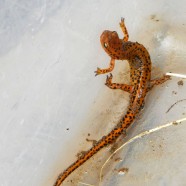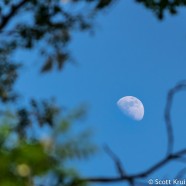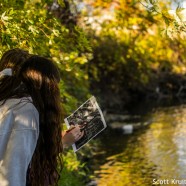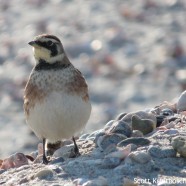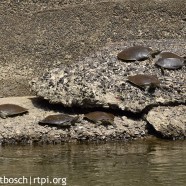Long-tailed Salamander (Eurycea longicauda)
Earlier this summer I caught my first glimpse of this handsome salamander, appropriately named the Long-tailed Salamander (Eurycea longicauda). A species of Special Concern in New York State, this uncommon salamander is at the northern fringes of its range and can be found along much of the southern Allegheny Plateau. Long-tails prefer cool woodland seeps and streams, but can occasionally be found along river banks under flat rocks or logs. As the temperatures continue to drop these salamanders will work their way deeper into rock cracks and crevices in order to protect themselves from...
Read MoreMoon Work
We at the Roger Tory Peterson Institute of Natural History do not only work during the day! I am not just talking about sitting behind our computers all night either. Moon work, or nocturnal field surveys, will be undertaken throughout the spring and summer seasons for species like the Common Nighthawk (Chordeiles minor), a New York species of Special Concern that nests in the Jamestown area, and for moths of all types. Those moths were a favorite area of study for Roger Tory Peterson, and we are looking to expand our knowledge on them as well as all the dragonflies, butterflies and other...
Read MoreRTPI and SUNY JCC studying Spiny Softshell Turtles
This fall we have two interns from SUNY Jamestown Community College working with us on the study and research of the Eastern Spiny Softshell Turtle (Apalone spinifera) population present in the Chadakoin River, located mere moments from our campus in Jamestown, New York. The state-listed turtle is listed as “special concern” and we are thankful to have this nearby area where we have found them successfully nesting. The Chadakoin River has a history of being surrounded by development and industry, making contamination of various sorts and water quality major concerns. However, the...
Read MoreHorned Lark (Eremophila alpestris)
The Horned Lark (Eremophila alpestris) is a species of open areas – the tundra, grasslands, fields, beaches and dunes and even the desert. Unsurprisingly they feed on the ground on insects and seeds and often take advantage of human activity disturbing areas such as mowed airports or piles of plowed earth or snow that expose more food. When it comes to the winter you will find them wherever it is the most bare. You can frequently spot them with Snow Buntings and, more rarely, the Lapland Longspur. They are also another species decreasing across much of their range and are listed as...
Read MoreMale Eastern Spiny Softshell Turtles
Here’s some of the boys – male Eastern Spiny Softshell Turtles (Apalone spinifera) – hanging out and basking Saturday afternoon before we were inundated with more rain. All of this constant precipitation is keeping water levels high making it harder to find them and impossible for us to do any trapping or tagging for research on the state-listed species. Our continuing observations and tracking will have to suffice.
Read More



